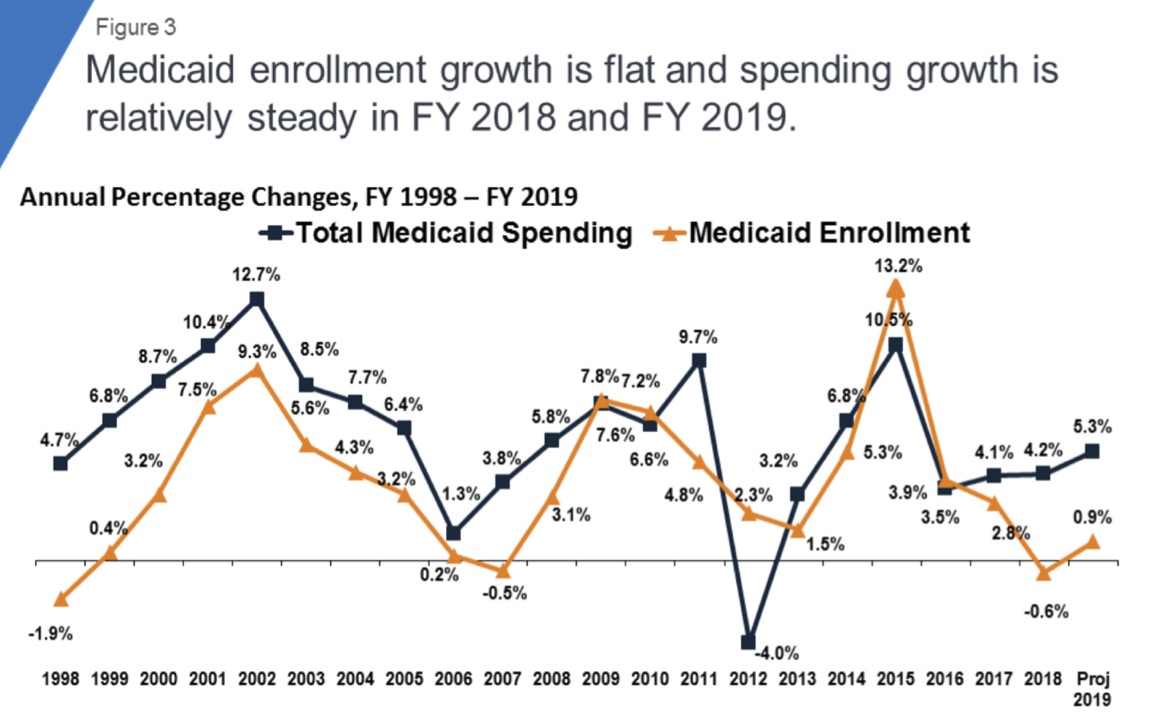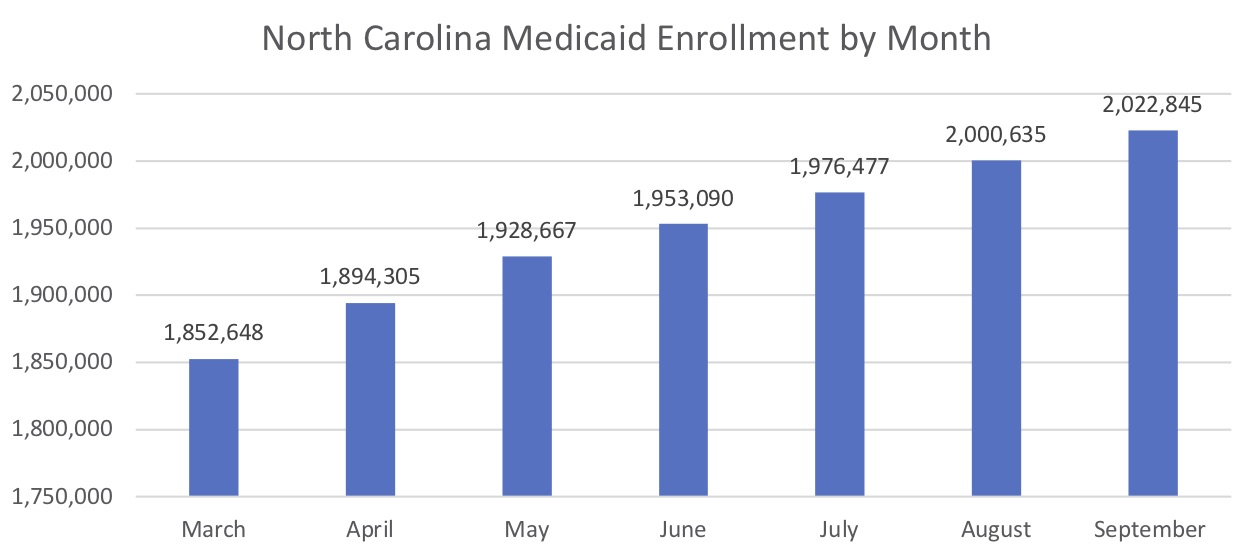Since the onset of the coronavirus and government actions to mitigate the spread, the U.S. has experienced a tremendous loss of jobs, business, and life. The federal government and the states have also been actively involved in providing relief packages in response. Congress seems unlikely to pass another one before the election, however, so the attention is now on state governments and their budgets. For this reason, prudent and responsible spending at the state level is essential to ensure the government’s future ability to provide core services.
One of those core services is health coverage for low-income mothers, children, the elderly, the blind, and the disabled through the Medicaid program. Medicaid is a countercyclical program, which means that downturns in the economy generally lead to increased Medicaid enrollment.
We see this phenomenon playing out right now as the country deals with the economic fallout from the pandemic. Medicaid enrollment is up across the country, including North Carolina, which means costs are up, too. States don’t have the flexibility to borrow and print money as the federal government does, so planning for the future is especially important when facing economic uncertainty.
This research brief will look at Medicaid from a national level and a state level in light of the ongoing economic fallout from the coronavirus and government lockdowns and shutdowns and discuss how the state should approach general spending and the Medicaid program going forward.
Medicaid and the Economy at the National Level
Aggregate Medicaid enrollment growth per year has varied over time based on different economic events and public-policy decisions. As you can see from the chart below, the annual percentage changes in Medicaid enrollment have varied from year to year.

From 2008 to 2010, there were massive increases in Medicaid enrollment due to the Great Recession. As the economy worsened during this period, states saw increases in their Medicaid rolls. Enrollment growth slowed from 2011 to 2013. In 2014, the Affordable Care Act’s Medicaid expansion kicked in, and enrollment skyrocketed as states expanded their Medicaid eligibility to include a new population of adults. Growth rates have slowed since they peaked in 2015, and in 2018, there was a decrease in Medicaid enrollment, a sign of a healthy economy.
So how have the coronavirus and government shutdowns affected national aggregate Medicaid enrollment? Researchers from the University of Minnesota peg the increase in enrollment to be at least 2.3 million in the three-month period from March 1 to June 1. This increase in Medicaid enrollment rivals that of the Great Recession and is a troubling sign for the public as more people qualify for the public health insurance program.
The current economic crisis caused by the pandemic and subsequent government shutdowns is even more shocking when you compare where we are now to where we were in 2019. The Wall Street Journal recently reported this on the economic gains made in 2019:
Median household income was $68,700 in 2019, up 6.8% from the prior year and the highest figure on record. The poverty rate was 10.5%, a drop of 1.3 percentage points from the year before. It was the fifth consecutive annual decline in poverty and put the poverty rate at its lowest level since 1959, the first year it was tracked.
While we are more than several months into the virus and government business restrictions and their economic fallout, the sharp increases in Medicaid rolls around the country mean tough times ahead for many Americans, and states that must pay for a portion of those costs.
Medicaid in North Carolina At a Glance
Medicaid is a joint federal/state venture, meaning the federal government and each state provide funding for its Medicaid program. The federal government funds 67.4 percent of North Carolina’s Medicaid program, and the rest is paid for by the state. The CARES Act, a federal relief package passed by Congress, raised the federal government’s amount from 67.4 to 73.4 percent.
How has North Carolina’s Medicaid program been affected by the pandemic? North Carolina Department of Health and Human Services provides monthly enrollment data for the Medicaid program. The monthly enrollment rates during the pandemic are listed in the chart below.

Source: NC DHHS Medicaid Enrollment Dashboard
Note: Enrollment numbers do not include enrollees using Family Planning Services
As you can see, North Carolina’s Medicaid program has seen enrollment increases every month since the pandemic started. As stated above, economic downturns mean an increase in Medicaid enrollment, so this was expected. But lawmakers should take note of this increase while considering future legislative commitments to spending.
What can we take away from these Medicaid numbers?
The takeaway for state lawmakers should be this: use caution when it comes to spending because there is so much uncertainty about the future. Medicaid is an open-ended entitlement program: if someone qualifies, the state must provide benefits. The more people that are eligible, the higher the state share of costs will be.
We know there will be revenue issues in state government due to the decrease in economic activity and delaying tax filings. In a recent research brief, John Locke’s Joe Coletti explains how the pandemic and shutdowns have impacted state revenue:
Total revenue for Fiscal Year (FY) 2019-20 fell $887 million from the previous year’s $24.826 billion to $23.939 billion. The final number is $1.031 billion lower than the $25.070 billion forecast in September 2019, but that gap is $612 million less than the $1.643 billion hole projected in May.
With state revenues falling, uncertainty surrounding the fall and winter, and so many lost jobs that will never come back, lawmakers must exercise restraint with spending to ensure that core government functions can continue. One such function is providing health coverage to the state’s population, most in need through Medicaid.
It’s another reason why the state should refrain from expanding Medicaid, which would cause spending on the program to explode. As I have written about before, there are already questions about Medicaid’s ability to serve the population for which it was designed properly. It would be a costly mistake to expand and commit to so much state spending when revenues are down and the situation in the coming months is unknowable.
There will be lawmakers who will insist on expanding Medicaid and spending as much state revenue as possible during this time. That approach would be unwise in the current environment. We see that national Medicaid numbers are rising now after leveling off or even decreasing in recent years. North Carolina’s Medicaid program has seen increases each month since the pandemic began.
Now is not the time to take on expanded government programs or ill-advised spending. Long-term planning is crucial during this time as we continue to deal with the virus and government business restrictions and their subsequent economic fallout.


